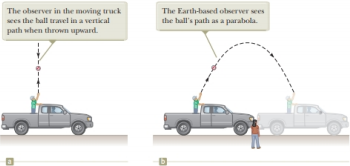
Which observer in Figure 38.1 sees the ball’s correct path? (a) the observer in the truck (b) the observer on the ground (c) both observers

Figure 38.1 Two observers watch the path of a thrown ball and obtain different results.
Answer to Problem 39.1QQ
Explanation of Solution
The laws of mechanics are same for all inertial frames. The inertial frame of the observer in truck has the inertial frame that is at moving at the velocity of the truck and the relative motion with the ball is zero so the observer in the truck sees the path of the ball move in a vertical path.
The inertial frame of the observer on the ground has the inertial frame that is at stationary and the relative motion with the ball is moving at the velocity of the truck so the observer on the ground sees the path of the ball move as a parabola.
Both the observer sees the correct path due to the validity if Newton’s laws of motion but the inertial frames are different so they see different paths of the ball.
Conclusion:
Since, both the observer sees the correct path but the inertial frames are different so they see different paths of the ball. Thus, option (c) is correct.
As the inertial frame of observer on the ground is stationary and the inertial frame of observer on the truck is moving. Thus, option (a) is incorrect.
As the inertial frames of both the observers are same due to which the path of the ball observed is different which contradicts the fact that the path seen by observer on the ground is only correct. Thus, option (b) is incorrect.
Want to see more full solutions like this?
Chapter 39 Solutions
Physics for Scientists and Engineers, Technology Update (No access codes included)
- Can someone help me with this question. Thanks.arrow_forwardIdentical rays of light enter three transparent blocks composed of different materials. Light slows down upon entering the blocks.arrow_forwardFor single-slit diffraction, calculate the first three values of (the total phase difference between rays from each edge of the slit) that produce subsidiary maxima by a) using the phasor model, b) setting dr = 0, where I is given by, I = Io (sin (10) ². 2arrow_forward
 Principles of Physics: A Calculus-Based TextPhysicsISBN:9781133104261Author:Raymond A. Serway, John W. JewettPublisher:Cengage Learning
Principles of Physics: A Calculus-Based TextPhysicsISBN:9781133104261Author:Raymond A. Serway, John W. JewettPublisher:Cengage Learning Physics for Scientists and Engineers with Modern ...PhysicsISBN:9781337553292Author:Raymond A. Serway, John W. JewettPublisher:Cengage Learning
Physics for Scientists and Engineers with Modern ...PhysicsISBN:9781337553292Author:Raymond A. Serway, John W. JewettPublisher:Cengage Learning Physics for Scientists and EngineersPhysicsISBN:9781337553278Author:Raymond A. Serway, John W. JewettPublisher:Cengage Learning
Physics for Scientists and EngineersPhysicsISBN:9781337553278Author:Raymond A. Serway, John W. JewettPublisher:Cengage Learning University Physics Volume 3PhysicsISBN:9781938168185Author:William Moebs, Jeff SannyPublisher:OpenStax
University Physics Volume 3PhysicsISBN:9781938168185Author:William Moebs, Jeff SannyPublisher:OpenStax Physics for Scientists and Engineers: Foundations...PhysicsISBN:9781133939146Author:Katz, Debora M.Publisher:Cengage Learning
Physics for Scientists and Engineers: Foundations...PhysicsISBN:9781133939146Author:Katz, Debora M.Publisher:Cengage Learning College PhysicsPhysicsISBN:9781938168000Author:Paul Peter Urone, Roger HinrichsPublisher:OpenStax College
College PhysicsPhysicsISBN:9781938168000Author:Paul Peter Urone, Roger HinrichsPublisher:OpenStax College





